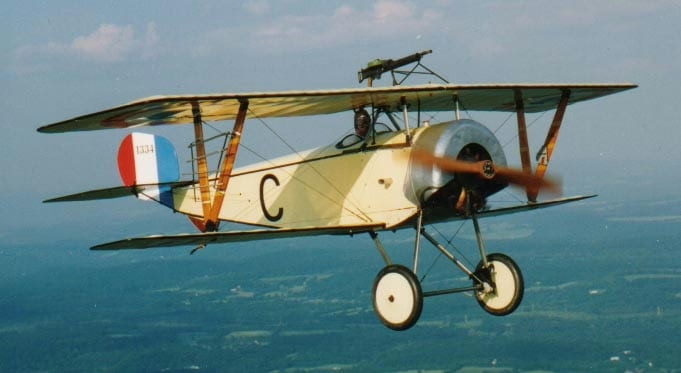Nieuport 11 « Bébé » History
The Nieuport 11 had its origins in a small, single-seat biplane powered by an 80 h.p. Gnome engine, designed by Gustave Delage to compete in the 1914 Gordon Bennett race. The race was cancelled by the onset of World War I, but the Nieuport 11 was quickly accepted for production as a fighter for the Aviation Militaire.
The Nieuport 11 was an attractive single-seater, powered by an 80 h.p. Gnome or Le Rhône rotary engine, and mounted a Lewis gun above the upper wing, to fire outside the propeller arc. Its diminutive size quickly earned it the nickname Bébé (Baby) when it entered service in the summer of 1915.
First orders for the Nieuport 11 « Bébé » came from Britain, but this was quickly followed by others from the French, Belgian, Italian, and Russian governments. Pilots were quick to appreciate the aeroplane’s excellent maneuverability and fast rate of climb, and the Nieuport 11 was the instrument on which several new air fighting tactics were pioneered in 1915-16. Ball, Bishop, de Rose, Navarre, and Nungesser were among the many famous fighter pilots who flew the Nieuport 11.
Six Nieuport 11s are known to have served with No. 3 Wing Royal Naval Air Service (R.N.A.S.), and since the type also served with No. 1 Wing, it seems reasonable to guess that at least a dozen of the ‘Nieuport Scouts’ for which R.N.A.S. serial numbers were allocated were of the Nieuport 11 ‘Bébé’ type. From March 1916, they also served in France with the Royal Flying Corps (R.F.C.). There are no known R.F.C. serials for Nieuport 11s, although five numbers were allocated to “Nieuport 13s”. These may have been Nieuport 11s, which were sometimes referred to as ‘13s’ – a reference to their metric wing area, and not an official designation. Many other R.F.C. serials were allocated to unspecified ‘Nieuport Scouts’, and doubtless some of these were Nieuport 11s.
In addition to France, the Nieuport 11 « Bébé » was also used in the Dardanelles by the R.N.A.S.
In Italy, Macchi built 646 of these aircraft, which remained standard equipment until mid-1917; Holland bought five and built a further 20 under license. The Nieuport 11’s chief contribution to the air war was its part, in company with the British Airco DH.2, in overcoming the so-called “Fokker scourge”.
By the end of 1916, a number of losses had been incurred from the weak lower wing structure, and in any case, the Nieuport 11 « Bébé »’s performance was becoming inadequate by this time. An experimental triplane version appeared in 1917, but this was not followed up.
Nieuport 11 « Bébé » Specifications
| Aircraft Type: |
| fighter |
| Dimensions: |
| wingspan: 24 ft, 9 in |
| length: 19 ft |
| height: 8 ft |
| Weights: |
| empty: 728 lb |
| gross: 1,058 lb |
| Power plant: |
| 1 × 80 hp Gnome rotary engine |
| Performance: |
| maximum speed: 97 mph |
| ceiling: 15,090 ft |
| maximum range: 200 mi |
| Armament: |
| 1 × 7.7 mm calibre machine gun |
| Service dates: |
| 1915–1916 |









